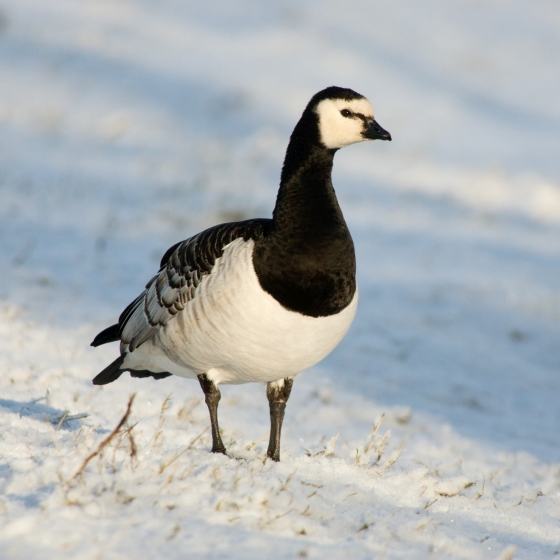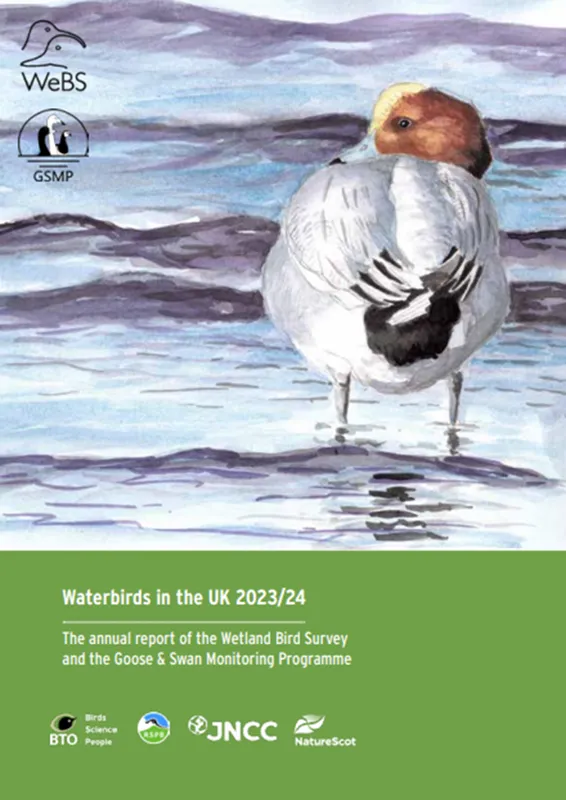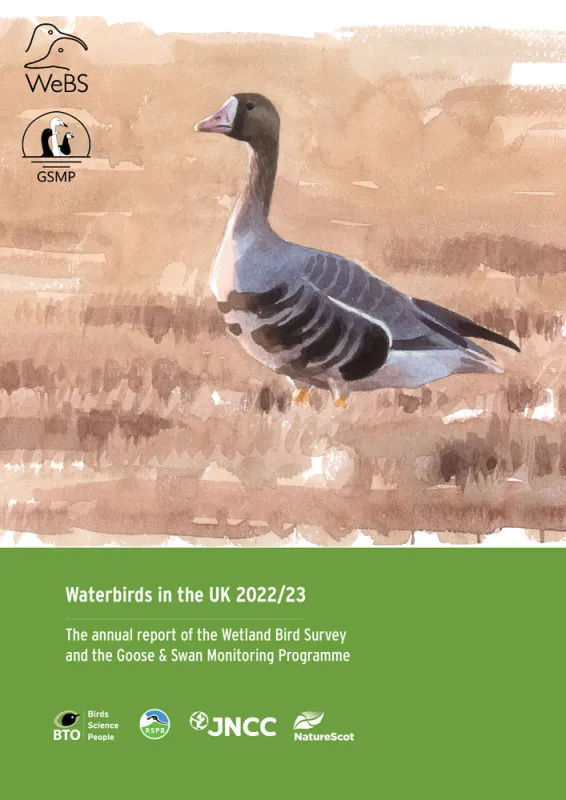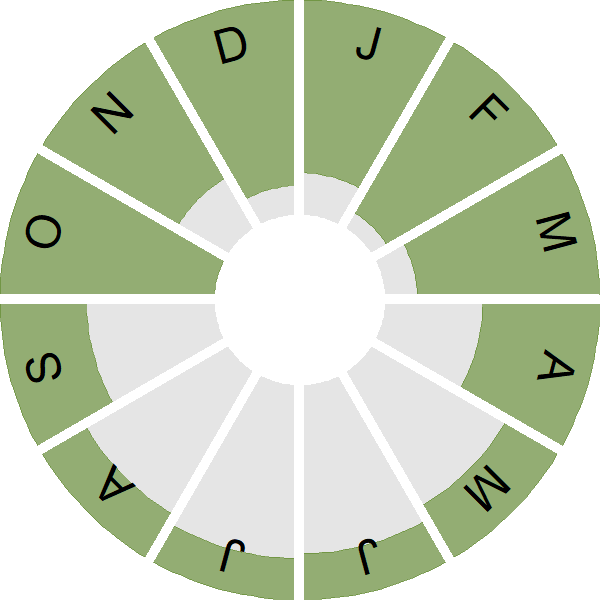Barnacle Goose

Introduction
The small size, yapping calls and sharply patterned greyscale plumage distinguish the Barnacle Goose from similar species.
This is a small migratory goose that arrives from the far north to winter in northern Britain. In recent decades, it has also become increasingly familiar as a naturalised resident, and might now be seen at almost any wetland and in any season.
While its seasonal abundances and absences were once the subject of legend and mystery, its migrations are now much better understood, thanks to ongoing ringing and tracking studies. Even though its wide Arctic range supports several distinct breeding populations, which appear to have largely separate migration routes and wintering areas, the lack of geographical variation and subspecies is in surprising contrast to most other goose species.

Key Stats
Identification
Songs and Calls
Call:
Alarm call:
Flight call:
Status and Trends
Conservation Status
Population Change
This species is mainly a winter visitor to the UK, but there is also a recently established and small naturalised breeding population which is increasing and expanding. This was estimated at 1,450 breeding pairs for the period 2012–15 (APEP4).
Distribution
Birds wintering along the coast and islands of northwestern Scotland and western Ireland are largely from the Greenland-breeding population, whilst the birds on the Solway Firth and on the east coast of Britain are largely from the Svalbard population. The naturalised population, which is found mainly in Britain, has a much wider distribution, and accounts for many of the occupied 10-km squares in inland areas, particularly throughout England.
Occupied 10-km squares in UK
2007/08–10/11
or view it on Bird Atlas Mapstore.
2008–11
or view it on Bird Atlas Mapstore.
European Distribution Map
Distribution Change
In Britain, a range increase of 79% is evident since the 1981–84 Winter Atlas, with many gains throughout England being associated with the increasing naturalised population. Along the western coast of Scotland, particularly in the strongholds of the Solway Firth, Islay and the Outer Hebrides, the number of occupied 10-km squares has largely remained stable, despite a population increase.
Change in occupied 10-km squares in the UK
from 1981–84 to 2007–11
or view it on Bird Atlas Mapstore.
from 1968–72 to 2008–11
or view it on Bird Atlas Mapstore.
Seasonality
Barnacle Geese can now be seen year-round, with large wintering flocks giving way to a small but growing naturalised breeding population in summer.
Weekly pattern of occurrence
The graph shows when the species is present in the UK, with taller bars indicating a higher likelihood of encountering the species in appropriate regions and habitats.

Movement
Britain & Ireland movement
Foreign locations of birds ringed or recovered in Britain & Ireland
Dots show the foreign destinations of birds ringed in Britain & Ireland, and the origins of birds ringed overseas that were subsequently recaptured, resighted or found dead in Britain & Ireland. Dot colours indicate the time of year that the species was present at the location.
- Winter (Nov-Feb)
- Spring (Mar-Apr)
- Summer (May-Jul)
- Autumn (Aug-Oct)

European movements
EuroBirdPortal uses birdwatcher's records, such as those logged in BirdTrack to map the flows of birds as they arrive and depart Europe. See maps for this species here.
The Eurasian-African Migration Atlas shows movements of individual birds ringed or recovered in Europe. See maps for this species here.
Biology
Productivity and Nesting
Nesting timing
Egg measurements
Clutch Size
Survival and Longevity
Survival is shown as the proportion of birds surviving from one year to the next and is derived from bird ringing data. It can also be used to estimate how long birds typically live.
View number ringed each year in the Online Ringing Report.
Lifespan
Survival of adults
Biometrics
Wing length and body weights are from live birds (source).
Wing length
Body weight
Ring Size
Classification, names and codes
Classification and Codes
- Order: Anseriformes
- Family: Anatidae
- Scientific name: Branta leucopsis
- Authority: Bechstein, 1803
- BTO 2-letter code: BY
- BTO 5-letter code: BARGO
- Euring code number: 1670
Alternate species names
- Catalan: oca de galta blanca
- Czech: berneška belolící
- Danish: Bramgås
- Dutch: Brandgans
- Estonian: valgepõsk-lagle
- Finnish: valkoposkihanhi
- French: Bernache nonnette
- Gaelic: Cathan
- German: Weißwangengans
- Hungarian: apácalúd
- Icelandic: Helsingi
- Irish: Gé Ghiúrainn
- Italian: Oca facciabianca
- Latvian: baltvaigu zoss
- Lithuanian: baltaskruoste bernikle
- Norwegian: Hvitkinngås
- Polish: bernikla bialolica
- Portuguese: ganso-marisco
- Slovak: bernikla bielolíca
- Slovenian: belolicna gos
- Spanish: Barnacla cariblanca
- Swedish: vitkindad gås
- Welsh: Gwydd Wyran
Research
Causes of Change and Solutions
Causes of change
There is little good evidence available regarding the drivers of the breeding population increase in this species in the UK. However, the species is likely to benefit from factors similar to those which have enabled other goose species (Canada Goose, Greylag Goose and more recently Egpytian Goose) to expand rapidly in the UK. These may include recent improvements in the availability and condition of wetland habitats, and (in urban parks) a relative scarcity of predators compared to more natural habitats. It is unclear whether the Barnacle Goose population will grow as rapidly as the other goose species as it may face competition from the three established species.
Publications (3)
Waterbirds in the UK 2023/24
Author:
Published: 2025
The report provides a single, comprehensive source of information on the current status and distribution of waterbirds in the UK for those interested in the conservation of the populations of these species and the wetland sites they use. Key stories from this report include more updates on avian influenza affecting migratory Barnacle Goose and Mute Swan, as well as a focus on the latest WeBS Alerts, looking at how wintering waterbirds are doing in protected areas. View the press release for this report
22.05.25
Reports Waterbirds in the UK

Waterbirds in the UK 2022/23
Author:
Published: Winter 2024
It provides a single, comprehensive source of information on the current status and distribution of waterbirds in the UK for those interested in the conservation of the populations of these species and the wetland sites they use. Data from this edition of Waterbirds in the UK provide further evidence that wintering ducks, geese, swans and waders are adapting to climate change by altering their migration.
25.04.24
Reports Waterbirds in the UK

More Evidence
More evidence from Conservation Evidence.com
Partners
Citing BirdFacts
If you wish to cite particular content in this page (e.g. a specific value) it is best to use the original sources as linked in the page. For a more general citation of the whole page please use: BTO (20XX) BirdFacts Species: profiles of birds occurring in the United Kingdom. BTO, Thetford (www.bto.org/birdfacts, accessed on xx/xx/xxxx).


